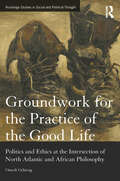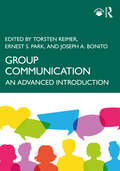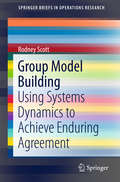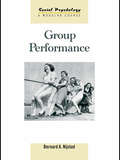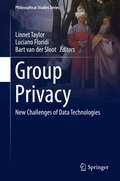- Table View
- List View
Grounds for Difference
by Rogers BrubakerOffering fresh perspectives on perennial questions of ethnicity, race, nationalism, and religion, Rogers Brubaker analyzes three forces that shape the politics of diversity and multiculturalism today: inequality as a public concern, biology as an asserted basis of racial and ethnic difference, and religion as a key terrain of public contestation.
Groundwater Sustainability: Conception, Development, and Application (Palgrave Studies in Environmental Sustainability)
by Robert E. MaceThis book will provide a comprehensive discussion of groundwater sustainability, including what it is, how its definition has changed over time, why traditional assessments of it are wrong, how assessments of it are ideally multidisciplinary efforts recognizing that policy is more controlling of outcomes than science, and why achieving it is difficult once pumping exceeds sustainable levels of pumping. The book will provide a nontechnical background of hydrogeology relevant to groundwater sustainability and present several case studies from around the United States and the world. The book has been designed to appeal to academics, students, and practitioners. Academics, particularly those just getting into the subject, will find the book a useful entry in terms of management concepts and political realities of attempting to achieve groundwater sustainability. It will also be useful to academics in that the book will include discussions on the history and development of groundwater sustainability and the practical aspects of aspiring to and achieving sustainable production. Although not a textbook, the book could be used as the basis for teaching a course or as a supplement to a hydrogeology or groundwater management class. Accordingly, the book will include questions and additional reading materials at the end of each chapter. This book will also be useful to practitioners through non-technical explanations of the sciences, discussions of the nuances of defining sustainability in aquifers, and the presentation of case studies where sustainable management has failed and succeeded.
Groundwork for the Practice of the Good Life: Politics and Ethics at the Intersection of North Atlantic and African Philosophy (Routledge Studies in Social and Political Thought)
by Omedi OchiengWhat makes for good societies and good lives in a global world? In this landmark work of political and ethical philosophy, Omedi Ochieng offers a radical reassessment of a millennia-old question. He does so by offering a stringent critique of both North Atlantic and African philosophical traditions, which he argues unfold visions of the good life that are characterized by idealism, moralism, and parochialism. But rather than simply opposing these flawed visions of the good life with his own set of alternative prescriptions, Ochieng argues that it is critically important to step back and understand the stakes of the question. Those stakes, he suggests, are to be found only through a social ontology – a comprehensive and in-depth account of the political, economic, and cultural structures that mark the boundaries and limits of life in the twenty-first century. It is only in light of this social ontology that Ochieng then proffers an alternative normative account of the good society and the good life – which he spells out as emergent from ecological embeddedness; social entanglement; embodied encounter; and aesthetic engenderment. At once sweeping and rigorous, incisive and subtle, original and revisionary, this book does more than just appeal to intellectuals and scholars across the humanities and social sciences – rather, it opens up the academic disciplines to a whole new landscape of exploration into the biggest and most pressing questions animating the human experience.
Groundwork for the Practice of the Good Life: Politics and Ethics at the Intersection of North Atlantic and African Philosophy (Routledge Studies in Social and Political Thought)
by Omedi OchiengWhat makes for good societies and good lives in a global world? In this landmark work of political and ethical philosophy, Omedi Ochieng offers a radical reassessment of a millennia-old question. He does so by offering a stringent critique of both North Atlantic and African philosophical traditions, which he argues unfold visions of the good life that are characterized by idealism, moralism, and parochialism. But rather than simply opposing these flawed visions of the good life with his own set of alternative prescriptions, Ochieng argues that it is critically important to step back and understand the stakes of the question. Those stakes, he suggests, are to be found only through a social ontology – a comprehensive and in-depth account of the political, economic, and cultural structures that mark the boundaries and limits of life in the twenty-first century. It is only in light of this social ontology that Ochieng then proffers an alternative normative account of the good society and the good life – which he spells out as emergent from ecological embeddedness; social entanglement; embodied encounter; and aesthetic engenderment. At once sweeping and rigorous, incisive and subtle, original and revisionary, this book does more than just appeal to intellectuals and scholars across the humanities and social sciences – rather, it opens up the academic disciplines to a whole new landscape of exploration into the biggest and most pressing questions animating the human experience.
A Group Analytic Approach to Understanding Mass Violence: The Holocaust, Group Hallucinosis and False Beliefs
by Bennett RothA Group Analytic Approach to Understanding Mass Violence makes an analytic examination of the enactment of genocide by Nazi Germany during World War II to explore how mass and state-sponsored violence can arise within societies and how the false beliefs that are used to justify such actions are propagated within society. Bennett Roth makes use of Bion’s concept of ‘Hallucinosis’ to describe the formation of false group beliefs that lead to murderous violence. Drawing on both group analysis and psychoanalysis, Roth explores in relation to genocide: how people form and identify with groups the role of family groups how conflict can arise and be managed how violence can arise and be justified by false beliefs how we can best understand these dysfunctional group dynamics to avoid such violence. A Group Analytic Approach to Understanding Mass Violence will be of great interest to all psychoanalysts and group analysts seeking to understand the role of false beliefs in their patients and society more generally. It will also be of interest to students and scholars of Holocaust studies programs or anyone seeking to understand the perpetration of genocide in the past and present.
A Group Analytic Approach to Understanding Mass Violence: The Holocaust, Group Hallucinosis and False Beliefs
by Bennett RothA Group Analytic Approach to Understanding Mass Violence makes an analytic examination of the enactment of genocide by Nazi Germany during World War II to explore how mass and state-sponsored violence can arise within societies and how the false beliefs that are used to justify such actions are propagated within society. Bennett Roth makes use of Bion’s concept of ‘Hallucinosis’ to describe the formation of false group beliefs that lead to murderous violence. Drawing on both group analysis and psychoanalysis, Roth explores in relation to genocide: how people form and identify with groups the role of family groups how conflict can arise and be managed how violence can arise and be justified by false beliefs how we can best understand these dysfunctional group dynamics to avoid such violence. A Group Analytic Approach to Understanding Mass Violence will be of great interest to all psychoanalysts and group analysts seeking to understand the role of false beliefs in their patients and society more generally. It will also be of interest to students and scholars of Holocaust studies programs or anyone seeking to understand the perpetration of genocide in the past and present.
Group Communication: An Advanced Introduction
by Torsten Reimer Ernest S. Park Joseph A. BonitoIn this comprehensive, advanced introduction to group communication, the field’s leading experts summarize theory, methodological advancements, and current research in the field. This book follows a coherent structure specifying clear objectives and evidence-based practical implications for the management of groups. Each chapter provides case study examples highlighting the role of communication for group functioning. The textbook takes a particular look at recent advancements in the research on virtual teams, the role of technology in group communication, and issues of diversity and inclusion, considering group communication in various situations including health and organizational contexts. It features theory-driven descriptions, an emphasis on empirical findings, and reflections on research methods. The book is an integrative and coherent textbook for advanced undergraduate and graduate group communication classes and a useful reference for students, scholars, and group communication professionals across different disciplines including communication studies, psychology, life sciences, business administration, management, and engineering. Online resources include a sample course syllabus, discussion questions, lecture slides, and a test-bank. They are available at www.routledge.com/9781032114712
Group Communication: An Advanced Introduction
In this comprehensive, advanced introduction to group communication, the field’s leading experts summarize theory, methodological advancements, and current research in the field. This book follows a coherent structure specifying clear objectives and evidence-based practical implications for the management of groups. Each chapter provides case study examples highlighting the role of communication for group functioning. The textbook takes a particular look at recent advancements in the research on virtual teams, the role of technology in group communication, and issues of diversity and inclusion, considering group communication in various situations including health and organizational contexts. It features theory-driven descriptions, an emphasis on empirical findings, and reflections on research methods. The book is an integrative and coherent textbook for advanced undergraduate and graduate group communication classes and a useful reference for students, scholars, and group communication professionals across different disciplines including communication studies, psychology, life sciences, business administration, management, and engineering. Online resources include a sample course syllabus, discussion questions, lecture slides, and a test-bank. They are available at www.routledge.com/9781032114712
Group Conflict and Co-operation: Their Social Psychology (Psychology Library Editions: Social Psychology)
by Muzafer SherifOriginally published in 1966 the author challenges the accepted theories of group conflict of the time, such as frustration and maladjustment. For him conflict and its accompanying aggressiveness are features of interaction between groups and he supports this theory with a detailed experimental study of controlled groups. At the time of publication, Dr Otto Klineberg, Director of the International Centre for Intergroup Relations at the Sorbonne wrote: ‘Social scientists everywhere owe a great debt of gratitude to Professor Sherif. The distinguished series of publications for which he and his co-workers are responsible have an honoured place in our libraries. In particular, his contributions to the field of intergroup relations are outstanding; his concept of "superordinate goals", based on a combination of theoretical insight and brilliant experimentation, has become a household word for those concerned with this significant problem. In his new volume, Group Conflict and Co-operation, he carries his analysis much further, not only describing the results of several original investigations, but also building a theoretical appraisal of an extensive research literature. The author has made still another significant contribution toward a better understanding of one of the most complex and disturbing phenomena of our time.’
Group Conflict and Co-operation: Their Social Psychology (Psychology Library Editions: Social Psychology)
by Muzafer SherifOriginally published in 1966 the author challenges the accepted theories of group conflict of the time, such as frustration and maladjustment. For him conflict and its accompanying aggressiveness are features of interaction between groups and he supports this theory with a detailed experimental study of controlled groups. At the time of publication, Dr Otto Klineberg, Director of the International Centre for Intergroup Relations at the Sorbonne wrote: ‘Social scientists everywhere owe a great debt of gratitude to Professor Sherif. The distinguished series of publications for which he and his co-workers are responsible have an honoured place in our libraries. In particular, his contributions to the field of intergroup relations are outstanding; his concept of "superordinate goals", based on a combination of theoretical insight and brilliant experimentation, has become a household word for those concerned with this significant problem. In his new volume, Group Conflict and Co-operation, he carries his analysis much further, not only describing the results of several original investigations, but also building a theoretical appraisal of an extensive research literature. The author has made still another significant contribution toward a better understanding of one of the most complex and disturbing phenomena of our time.’
Group Creativity: Innovation through Collaboration
by Bernard A. Nijstad Paul B. PaulusCreativity often leads to the development of original ideas that are useful or influential, and maintaining creativity is crucial for the continued development of organizations in particular and society in general. Most research and writing has focused on individual creativity. Yet, in recent years there has been an increasing acknowledgment of the importance of the social and contextual factors in creativity. Even with the information explosion and the growing necessity for specialization, the development of innovations still requires group interaction at various stages in the creative process. Most organizations increasingly rely on the work of creative teams where each individual is an expert in a particular area. This volume summarizes the exciting new research developments on the processes involved in group creativity and innovation, and explores the relationship between group processes, group context, and creativity. It draws from a broad range of research perspectives, including those investigating cognition, groups, creativity, information systems, and organizational psychology. These different perspectives have been brought together in one volume in order to focus attention on this developing literature and its implications for theory and application. The chapters in this volume are organized into two sections. The first focuses on how group decision making is affected by factors such as cognitive fixation and flexibility, group diversity, minority dissent, group decision-making, brainstorming, and group support systems. Special attention is devoted to the various processes and conditions that can inhibit or facilitate group creativity. The second section explores how various contextual and environmental factors affect the creative processes of groups. The chapters explore issues of group autonomy, group socialization, mentoring, team innovation, knowledge transfer, and creativity at the level of cultures and societies. The research presented in this section makes it clear that a full understanding of group creativity cannot be accomplished without adequate attention to the group environment. It will be a useful source of information for scholars, practitioners, and students wishing to understand and facilitate group creativity.
Group Creativity: Innovation through Collaboration
by Bernard A. Nijstad Paul B. PaulusCreativity often leads to the development of original ideas that are useful or influential, and maintaining creativity is crucial for the continued development of organizations in particular and society in general. Most research and writing has focused on individual creativity. Yet, in recent years there has been an increasing acknowledgment of the importance of the social and contextual factors in creativity. Even with the information explosion and the growing necessity for specialization, the development of innovations still requires group interaction at various stages in the creative process. Most organizations increasingly rely on the work of creative teams where each individual is an expert in a particular area. This volume summarizes the exciting new research developments on the processes involved in group creativity and innovation, and explores the relationship between group processes, group context, and creativity. It draws from a broad range of research perspectives, including those investigating cognition, groups, creativity, information systems, and organizational psychology. These different perspectives have been brought together in one volume in order to focus attention on this developing literature and its implications for theory and application. The chapters in this volume are organized into two sections. The first focuses on how group decision making is affected by factors such as cognitive fixation and flexibility, group diversity, minority dissent, group decision-making, brainstorming, and group support systems. Special attention is devoted to the various processes and conditions that can inhibit or facilitate group creativity. The second section explores how various contextual and environmental factors affect the creative processes of groups. The chapters explore issues of group autonomy, group socialization, mentoring, team innovation, knowledge transfer, and creativity at the level of cultures and societies. The research presented in this section makes it clear that a full understanding of group creativity cannot be accomplished without adequate attention to the group environment. It will be a useful source of information for scholars, practitioners, and students wishing to understand and facilitate group creativity.
Group Dynamics For Teams
by Daniel J. Jay LeviIncorporating the latest research throughout, Daniel Levi's Fifth Edition of Group Dynamics for Teams explains the basic psychological concepts of group dynamics, focusing on their application with teams in the workplace. Grounded in psychology research and a practical focus on organizational behavior issues, this engaging book helps readers understand and more effectively participate in teams.
Group Dynamics For Teams (PDF)
by Daniel J. Jay LeviIncorporating the latest research throughout, Daniel Levi's Fifth Edition of Group Dynamics for Teams explains the basic psychological concepts of group dynamics, focusing on their application with teams in the workplace. Grounded in psychology research and a practical focus on organizational behavior issues, this engaging book helps readers understand and more effectively participate in teams.
The Group Effect: Social Cohesion and Health Outcomes
by John BruhnSociologists and anthropologists have had a long interest in studying the ways in which cultures shaped different patterns of health, disease, and mortality. Social scientists have documented low rates of chronic disease and disability in non-Western societies and have suggested that social stability, cultural homogeneity and social cohesion may play a part in explaining these low rates. On the other hand, in studies of Western societies, social scientists have found that disease and mortality assume different patterns among various ethnic, cultural and social-economic groups. The role of stress, social change and a low degree of cohesion have been suggested, along with other factors as contributing to the variable rates among different social groups. Social cohesion has been implicated in the cause and recovery from both physical and psychological illnesses. Although there has been a large amount of work established the beneficial effects of cohesion on health and well-being, relatively little work has focused on HOW increased social cohesion sustains or improves health. This work is based on the premise that there are risk factors, including social cohesion that regulate health and disease in groups. One of the challenges is how to measure social cohesion – it can be readily observed and experienced but difficult to quantify. A better understanding of how social cohesion works will be valuable to improving group-level interventions.
Group Experiment and Other Writings: The Frankfurt School on Public Opinion in Postwar Germany
by Friedrich Pollock Theodor Adorno Andrew J Perrin Jeffrey K OlickDuring the occupation of West Germany after the Second World War, the American authorities commissioned polls to assess the values and opinions of ordinary Germans. They concluded that the fascist attitudes of the Nazi era had weakened to a large degree. Theodor W. Adorno and his Frankfurt School colleagues, who returned in 1949 from the United States, were skeptical. They held that standardized polling was an inadequate and superficial method for exploring such questions. In their view, public opinion is not simply an aggregate of individually held opinions, but is fundamentally a public concept, formed through interaction in conversations and with prevailing attitudes and ideas “in the air.” In Group Experiment, edited by Friedrich Pollock, they published their findings on their group discussion experiments that delved deeper into the process of opinion formation. Andrew J. Perrin and Jeffrey K. Olick make a case that these experiments are an important missing link in the ontology and methodology of current social-science survey research.
Group Identity Fabrication Theory: A Communication-ecological Account with Social-theoretical Implications
by Robin KurillaTo date, there has been no comprehensive and coherent approach to determining the communicative and precommunicative processes involved in the construction of group identities. The present study fills this gap by developing a unified theoretical foundation that can be used to capture empirical construction processes. Moreover, it contributes to the domain of group communication research. It creates a basic theoretical riverbed that provides a conceptual foundation for the conception of inter- and intra-group communication, which does not take its starting point from 'objective' categories, but from de facto socialization processes. In addition, the architecture of an innovative social theory is presented using the example of the construction of group identity, which satisfies the demands of epistemological interests in communication studies and possibly also in other disciplines.
Group Integration and Multiculturalism: Theory, Policy and Practice (Palgrave Politics of Identity and Citizenship Series)
by Dan PfefferWith immigration fulfilling the role of population maintenance in many Western democracies, how should newcomers be welcomed? Pfeffer argues that states ought to promote group integration for communities that have settled through immigration, facilitating the development of group institutions that enable communication with the receiving society.
The Group Leader's Toolkit: Activities and Strategies for Working with Groups
by Robin DynesAn essential resource for all kinds of groups, these tried and tested strategies will stimulate and encourage full participation from all group members. Provides ideas for introducing group members to each other, breaking down barriers, energising people, helping people learn, moving the group on, building trust between group members, motivating people, assessing and evaluating the group, managing behaviour and personal responsibility, and ending sessions. The activities are set out in a clear, easy to follow format, with variations and guidance for adapting the activities. Will enable group leaders to promote group members' self development, meet the needs of their different learning styles, stimulate their creativity and develop their thinking skills. This toolkit is an invaluable resource for tutors, occupational therapists, nurses, care staff, probation staff, youth leaders or anyone - new or experienced - who works with groups.
The Group Leader's Toolkit: Activities and Strategies for Working with Groups
by Robin DynesAn essential resource for all kinds of groups, these tried and tested strategies will stimulate and encourage full participation from all group members. Provides ideas for introducing group members to each other, breaking down barriers, energising people, helping people learn, moving the group on, building trust between group members, motivating people, assessing and evaluating the group, managing behaviour and personal responsibility, and ending sessions. The activities are set out in a clear, easy to follow format, with variations and guidance for adapting the activities. Will enable group leaders to promote group members' self development, meet the needs of their different learning styles, stimulate their creativity and develop their thinking skills. This toolkit is an invaluable resource for tutors, occupational therapists, nurses, care staff, probation staff, youth leaders or anyone - new or experienced - who works with groups.
Group Model Building: Using Systems Dynamics to Achieve Enduring Agreement (SpringerBriefs in Operations Research)
by Rodney ScottThis book describes the cognitive and interpersonal effects of group model building, and presents empirical research on what group model building achieves and how. Further, it proposes an integrated causal mechanism for the effects on participants. There have been multiple previous attempts at explaining the effects of group model building on participants, and this book integrates these various theories for the first time.The causal mechanisms described here suggest a variety of design elements that should be included in group model building practice. For example, practitioners typically try to reduce complexity for clients, to make the process feel more accessible. In contrast, the findings presented here suggest that the very act of muddling through complexity increases participants’ affective commitment to the group and the decisions made.The book also describes implications for theory and practice. System dynamics has traditionally been interested in using technical modeling processes to make policy recommendations. Group model building demonstrates that these same techniques also have implications for group decision making as a method for negotiating agreement. The book argues for the value of group model building as a mediating or negotiating tool, rather than merely a positivist tool for technical problems.
Group Performance
by Bernard A. NijstadPeople interact and perform in group settings in all areas of life. Organizations and businesses are increasingly structuring work around groups and teams. Every day, we work in groups such as families, friendship groups, societies and sports teams, to make decisions and plans, solve problems, perform physical tasks, generate creative ideas, and more. Group Performance outlines the current state of social psychological theories and findings concerning the performance of groups. It explores the basic theories surrounding group interaction and development and investigates how groups affect their members. Bernard A. Nijstad discusses these issues in relation to the many different tasks that groups may perform, including physical tasks, idea generation and brainstorming, decision-making, problem-solving, and making judgments and estimates. Finally, the book closes with an in-depth discussion of teamwork and the context in which groups interact and perform. Offering an integrated approach, with particular emphasis on the interplay between group members, the group task, interaction processes and context, this book provides a state-of-the-art overview of social psychological theory and research. It will be highly valuable to undergraduates, graduates and researchers in social psychology, organizational behavior and business.
Group Performance
by Bernard A. NijstadPeople interact and perform in group settings in all areas of life. Organizations and businesses are increasingly structuring work around groups and teams. Every day, we work in groups such as families, friendship groups, societies and sports teams, to make decisions and plans, solve problems, perform physical tasks, generate creative ideas, and more. Group Performance outlines the current state of social psychological theories and findings concerning the performance of groups. It explores the basic theories surrounding group interaction and development and investigates how groups affect their members. Bernard A. Nijstad discusses these issues in relation to the many different tasks that groups may perform, including physical tasks, idea generation and brainstorming, decision-making, problem-solving, and making judgments and estimates. Finally, the book closes with an in-depth discussion of teamwork and the context in which groups interact and perform. Offering an integrated approach, with particular emphasis on the interplay between group members, the group task, interaction processes and context, this book provides a state-of-the-art overview of social psychological theory and research. It will be highly valuable to undergraduates, graduates and researchers in social psychology, organizational behavior and business.
Group Privacy: New Challenges of Data Technologies (Philosophical Studies Series #126)
by Linnet Taylor Luciano Floridi Bart van der SlootThe goal of the book is to present the latest research on the new challenges of data technologies. It will offer an overview of the social, ethical and legal problems posed by group profiling, big data and predictive analysis and of the different approaches and methods that can be used to address them. In doing so, it will help the reader to gain a better grasp of the ethical and legal conundrums posed by group profiling. The volume first maps the current and emerging uses of new data technologies and clarifies the promises and dangers of group profiling in real life situations. It then balances this with an analysis of how far the current legal paradigm grants group rights to privacy and data protection, and discusses possible routes to addressing these problems. Finally, an afterword gathers the conclusions reached by the different authors and discuss future perspectives on regulating new data technologies.
Group Problem Solving
by Patrick R. LaughlinExperimental research by social and cognitive psychologists has established that cooperative groups solve a wide range of problems better than individuals. Cooperative problem solving groups of scientific researchers, auditors, financial analysts, air crash investigators, and forensic art experts are increasingly important in our complex and interdependent society. This comprehensive textbook--the first of its kind in decades--presents important theories and experimental research about group problem solving. The book focuses on tasks that have demonstrably correct solutions within mathematical, logical, scientific, or verbal systems, including algebra problems, analogies, vocabulary, and logical reasoning problems. The book explores basic concepts in group problem solving, social combination models, group memory, group ability and world knowledge tasks, rule induction problems, letters-to-numbers problems, evidence for positive group-to-individual transfer, and social choice theory. The conclusion proposes ten generalizations that are supported by the theory and research on group problem solving. Group Problem Solving is an essential resource for decision-making research in social and cognitive psychology, but also extremely relevant to multidisciplinary and multicultural problem-solving teams in organizational behavior, business administration, management, and behavioral economics.


